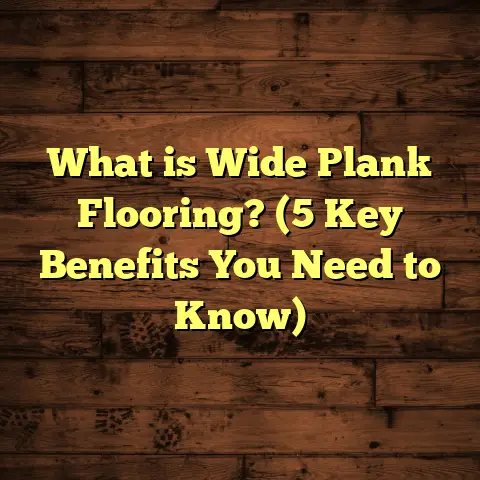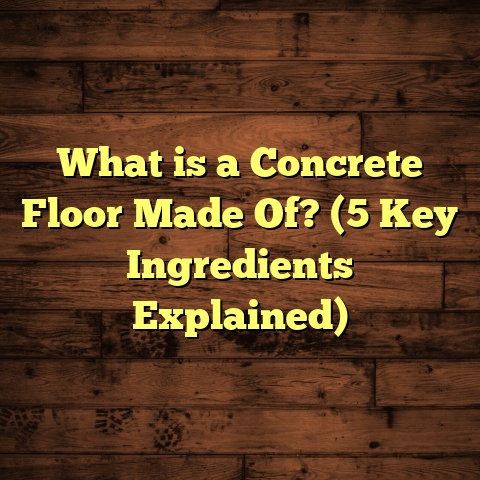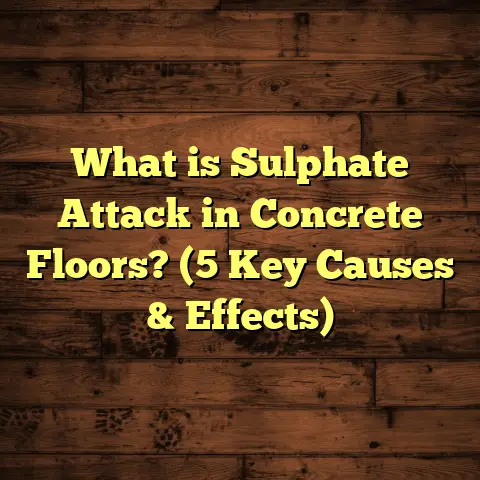What is Polyvinyl Flooring? (5 Key Benefits You Must Know!)
Innovation keeps reshaping the way we build and design our homes, especially when it comes to flooring. Over the years, I’ve seen materials evolve from traditional wood and tile to more advanced options that promise durability, style, and affordability. One material that has caught my attention—and probably should catch yours—is polyvinyl flooring. If you’re wondering what makes it stand out or if it’s the right choice for your space, I’m here to walk you through everything you need to know.
What is Polyvinyl Flooring?
Polyvinyl flooring, often called vinyl flooring, is a synthetic flooring material made primarily from polyvinyl chloride (PVC). Unlike natural materials like wood or stone, polyvinyl is manufactured using plastic compounds that are processed into sheets or tiles. This gives it unique properties that make it highly versatile.
When I first worked with polyvinyl flooring years ago, I was surprised by how much it had improved from the cheap, thin sheets I remembered from decades ago. Modern polyvinyl flooring is engineered to be thick, resilient, and available in endless designs—from wood and stone looks to bold patterns. It’s a go-to choice for many homeowners and contractors because it balances cost-effectiveness with performance.
The manufacturing process involves combining PVC resin with additives such as plasticizers (for flexibility), stabilizers (to resist heat and light damage), and pigments (for color). The end product can be either sheet vinyl or vinyl tiles/planks.
How is it Different from Other Flooring Types?
Unlike laminate or hardwood, polyvinyl flooring doesn’t have a natural wooden core or surface. Its synthetic makeup means it resists moisture better than many natural materials. Also, polyvinyl is softer underfoot compared to tile or hardwood, which makes it more comfortable to stand on for long periods—a detail I appreciated during long installation projects.
5 Key Benefits of Polyvinyl Flooring You Must Know
1. Durability That Surprises
I’ve installed polyvinyl floors in homes with high foot traffic—think busy families with kids and pets—and I’ve been impressed by how well it holds up. This flooring can withstand scratches, dents, and stains better than many alternatives.
Here’s a data point that caught my attention: According to a study by the Resilient Floor Covering Institute, polyvinyl flooring can last anywhere from 10 to 20 years depending on quality and usage, making it a solid long-term investment.
One project involved a daycare center where spills and constant movement were daily challenges. The polyvinyl floor remained intact and easy to clean after years of use, proving its toughness in demanding environments.
Another example: A homeowner who adopted multiple large dogs told me how this flooring resisted scratches from claws better than their previous hardwood floor, which had become visibly worn in just two years.
2. Water Resistance Makes It Ideal for Wet Areas
Have you ever worried about water damage ruining your floor? Polyvinyl flooring is mostly waterproof because PVC doesn’t absorb moisture. This makes it a smart choice for kitchens, bathrooms, basements, and laundry rooms.
In fact, it outperforms hardwood and laminate in this area by a wide margin. Hardwood can warp or swell with moisture exposure, while laminate tends to delaminate if water seeps in.
During one bathroom remodel, the client was skeptical about using vinyl but was amazed at how it handled splashes without any signs of damage months later. It’s also easy to clean up after spills—just wipe and go.
In basements prone to humidity or minor flooding, I’ve recommended polyvinyl flooring as a reliable solution. The material’s resistance to mold and mildew growth adds peace of mind.
A recent study by the American Society of Home Inspectors noted a significant decrease in water-related floor damage claims where vinyl had been installed compared to hardwood or laminate.
3. Cost-Effective Without Compromising Looks
If you’re budgeting a flooring project, polyvinyl often offers one of the best value propositions. It typically costs less per square foot than hardwood or stone tiles.
For example, basic sheet vinyl can run as low as $2 per square foot installed, while luxury vinyl planks (LVP) that mimic wood or stone textures range between $3 to $7 per square foot installed. Compare that to hardwood floors which often start around $8 per square foot.
Beyond price, polyvinyl’s versatility in design means you don’t have to sacrifice style for budget. Some LVP products are so realistic that even trained eyes struggle to tell them apart from real wood.
I remember a project where a client wanted the look of expensive oak without the price tag. Using luxury vinyl planks gave them exactly what they wanted without blowing their budget—and the floor still looks great after three years.
4. Easy Installation Saves Time and Money
When I started using polyvinyl flooring regularly, I noticed how much faster the installation was compared to hardwood or tile.
There are several installation methods:
- Glue-down: Sheets or tiles are glued directly to the subfloor.
- Click-lock planks: Similar to laminate, these snap together without glue.
- Loose lay: Heavy sheets or planks stay in place by weight and friction alone.
This flexibility means homeowners can sometimes do the installation themselves, reducing labor costs. In some cases, replacing old flooring with polyvinyl requires minimal prep work, which speeds up the project timeline.
A recent renovation I worked on had a turnaround time of just two days for a 1,000 sq ft kitchen and dining area—remarkably fast compared to traditional tile work.
I once coached a friend through installing click-lock vinyl planks in her rental property. She was thrilled with how easy it was—even as a DIY beginner—and how professional the final look turned out.
5. Comfortable Underfoot with Sound Absorption
Compared to tile or concrete floors, polyvinyl offers a softer surface that’s gentler on your feet and joints. This makes standing or walking on it all day much easier.
Plus, it absorbs sound better than hard surfaces, reducing echoes and noise transfer between rooms—a feature appreciated in busy households or apartments.
Some vinyl floors come with an attached foam backing or underlay for even more comfort and noise reduction. I personally recommend this for spaces like living rooms or bedrooms where comfort matters most.
A client once told me she felt less fatigued after switching her kitchen floor from tile to luxury vinyl plank because it was easier on her knees during cooking marathons.
Breaking Down Types of Polyvinyl Flooring
You might be wondering about different types of polyvinyl flooring available. Here’s a quick overview based on what I’ve seen in my projects:
Sheet Vinyl
This comes in large rolls that cover entire rooms without seams if installed properly. Sheet vinyl is great for moisture-prone areas due to its water resistance and fewer joints where water can seep through.
It’s usually thinner than luxury vinyl planks but can be quite durable with the right wear layer.
Luxury Vinyl Planks (LVP)
LVP mimics real wood planks beautifully. It’s thicker than sheet vinyl and often comes with an attached underlayment for added comfort and sound absorption.
I’ve installed LVP in living rooms and bedrooms where clients wanted the warmth of wood but needed something tougher against kids and pets.
Luxury Vinyl Tiles (LVT)
These imitate stone or ceramic tiles but provide the softness of vinyl. LVT is perfect if you want the look of tile without coldness or hardness underfoot.
One restaurant I worked with installed LVT in their dining area—it looked upscale but was far safer and quieter than ceramic tile would have been.
Installation Insights From My Experience
Installing polyvinyl flooring might sound straightforward, but there are some tips I learned over time that can save headaches:
- Subfloor Preparation: The surface needs to be clean, dry, flat, and free from debris. Even small bumps can telegraph through thin vinyl.
- Acclimate Material: Vinyl should sit in the room for at least 24 hours before installation so it adjusts to temperature and humidity.
- Use Proper Adhesives: For glue-down varieties, using manufacturer-recommended adhesives ensures proper bonding.
- Seam Sealing: For sheet vinyl installations, seams must be sealed carefully to prevent water infiltration.
- Expansion Gaps: Like wood floors, some vinyl types need space around edges for expansion to avoid buckling.
I remember one job where skipping acclimation caused slight buckling near windows due to temperature differences—lesson learned!
Maintaining Polyvinyl Flooring: Tips That Work
Keeping your polyvinyl floors looking great isn’t complicated if you follow some simple steps:
- Sweep or vacuum regularly to remove dirt and grit that can scratch the surface.
- Use a damp mop with a mild cleaner designed for vinyl floors.
- Avoid waxes or harsh chemicals that can leave residues.
- Place protective pads under furniture legs.
- Clean spills promptly to reduce staining risk.
Years ago, I advised a client who had trouble with sticky spots from kitchen spills. After switching her cleaning routine to gentle soap and water only, her floors stayed spotless with no damage.
Design Trends I’ve Noticed With Polyvinyl Flooring
In recent years, manufacturers have pushed the limits of design realism with polyvinyl flooring:
- Textured Surfaces: Embossed finishes mimic wood grain or stone textures so well you can almost feel them.
- Wide Planks: Larger plank sizes provide a modern look often seen in upscale homes.
- Bold Patterns: Some brands offer geometric or intricate patterns that add personality without overwhelming a room.
People love using vinyl in unexpected places now—like bathrooms with heated floors underneath vinyl planks for cozy mornings.
Challenges I’ve Faced and How I Fixed Them
Not everything has been smooth sailing with polyvinyl flooring—there are challenges:
- Indentations from Heavy Furniture: Sometimes very heavy furniture leaves dents if not moved carefully.
- Fading from Sunlight: Prolonged direct sunlight can cause some colors to fade.
- Improper Installation Issues: Poor subfloor prep leads to bumps or peeling.
On one project, heavy bookshelves left marks on softer vinyl sheets. We solved this by placing furniture coasters underneath and switching to thicker planks in other rooms.
Environmental Considerations
You might ask if polyvinyl flooring is environmentally friendly. PVC is plastic-based but many brands now include recycled content or programs for recycling old floors.
Recent advancements include:
- Reducing harmful additives during manufacturing.
- Creating recyclable vinyl products.
- Offering products certified for low VOC emissions for better indoor air quality.
Choosing floors made by responsible manufacturers helps reduce environmental impact.
Case Study: A Full Home Renovation With Polyvinyl Flooring
Let me share a detailed example from one of my recent projects—a full home renovation where polyvinyl flooring was used throughout:
The homeowners wanted durable floors that could handle kids’ messes but still look elegant. We chose luxury vinyl planks in a warm oak finish for most spaces and luxury vinyl tiles with stone patterns for bathrooms.
Installation took just under a week for the entire 2,500 sq ft home—a fraction of time compared to hardwood or tile. The owners were thrilled with how realistic the floors looked. After six months of heavy family use—including spills, pets running around, and frequent cleanup—the floors showed no signs of wear.
Their feedback was clear: “Feels like real wood but so much easier to live with.” This project reinforced why I trust vinyl for many residential jobs.
Frequently Asked Questions (Expanded)
Can Polyvinyl Flooring Be Used Outdoors?
Generally no. Polyvinyl isn’t designed for outdoor use because UV rays degrade PVC over time. For outdoor areas like patios, other materials like porcelain tile or composite decking work better.
How Does Polyvinyl Flooring Hold Up Against Heat?
While durable at room temperature, extreme heat can cause softening or warping. Avoid placing hot pots directly on the floor; use trivets or mats instead.
Are There Health Concerns With PVC Floors?
Modern polyvinyl products meet strict indoor air quality standards and emit very low VOCs. Choosing certified low-emission products reduces risk further.
What’s the Best Way To Repair Damaged Sections?
For plank or tile products, individual pieces can be replaced without disturbing the whole floor. Sheet vinyl repairs are trickier but patches can sometimes be glued down after cutting out damaged areas.
Final Thoughts on Polyvinyl Flooring
After working closely with polyvinyl flooring over many projects and years, I believe it offers an outstanding balance of affordability, durability, style flexibility, and ease of care. It’s especially suited for anyone needing practical solutions without giving up aesthetics.
If you want floors that last through everyday chaos but still look inviting and modern—polyvinyl might just be your best pick. Whether you’re renovating a kitchen, outfitting a commercial space, or finishing a basement gym area, this material delivers performance that stands up over time—and I’ve seen it firsthand many times over.
Got questions about your specific project? Feel free to ask—I’m always happy to share more insights from my experience!





